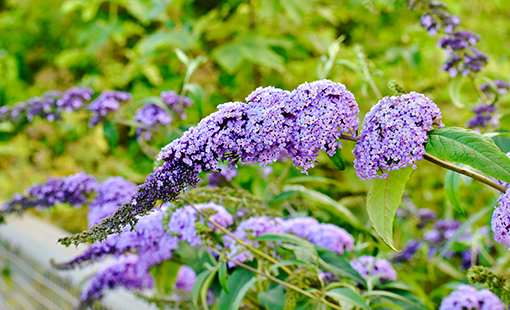
Low Maintenance Butterfly Bush
Butterfly bush is a deciduous shrub with an arching habit and impressive flowers. It’s easy to grow and produces striking flower spikes. Thanks to the magic of cultivar developers, the flowers now come in a number of colors, including pink, yellow blue and multicolor. And as the name suggests, these shrubs are known as magnets for butterflies, which are the closest thing to real fairies that our gardens will ever enjoy. Red-flowering butterfly bushes will even attract hummingbirds.
Butterfly bushes are cultivated to suit many different gardening preferences. Some can grow up to 12 feet tall, while others are relatively small. Some varieties produce large clusters of flowers while others produce flowering spikes. Butterfly bushes were first brought to England from Asia in 1774 by the botanist Adam Buddle (for whom the plant was named). New varieties are still being discovered in remote areas of China and the Himalayas.
Care
The popularity of butterfly bushes is no surprise as they’re beautiful, easy to grow and require minimal day-to-day care. Even major storms have little effect on these hardy shrubs. They thrive in harsh environments, such as polluted urban settings. They’re also resistant to insects, drought and stress. The bushes require little attention, so even weekend gardeners can enjoy their lovely blooms and resident butterflies.
Butterfly bush is very easy to grow in average, medium moisture, well-drained soil in a full sun location. If planting more then one, space them well apart—five to six feet. Blend in peat moss before planting if the soil is dense and poorly draining.
In colder climates, butterfly bush often dies back to the ground in winter and is treated like a herbaceous perennial. And in warm climates, they can be pruned back in the same way to keep them under control and stimulate better blooming. Be wary of this plant’s tendency to aggressively spread through self-seeding. Removing the spent flower clusters before they can scatter seeds will help control the plant.
There are no serious pest or disease problems with butterfly bush, although spider mites can be an issue, and nematodes can be a problem in the South.
Light
Butterfly bush needs full sun and will become weedy and sparse if grown in shady conditions.
Soil
This plant will thrive in any average, well-drained soil that gets an average amount of moisture.
Water
This plant likes a medium-moisture environment and will do poorly in boggy locations that don’t drain well. They will thrive on 1/2 inch of water by rain or irrigation each week.
Temperature and Humidity
Butterfly bush thrives throughout its hardiness zone range, but expect it to die back to ground level in winter in zones 5 and 6.
Fertilizer
This plant needs no fertilizer, other than a thin layer of compost spread over the root zone each spring.
Pruning
The spent flower spikes of butterfly bush should be removed promptly after flowering to stimulate continued blooming right up to frost. This plant grows very fast, and pruning it down all the way to ground level each spring stimulates vigorous growth and profuse flowering.
Information courtesy of TheSpruce.com

 Adams Fairacre Farms
Adams Fairacre Farms